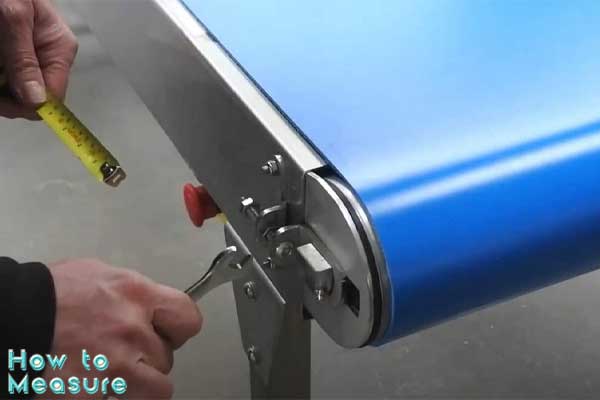Conveyor belts play a crucial role in various industries by efficiently transporting materials from one point to another. To ensure that conveyor belts work effectively, it is important to measure them accurately. Measuring a conveyor belt involves precise length, width, and thickness measurements. This information is crucial for determining the belt’s size and ensuring it fits properly on the conveyor system. This guide will outline the steps of How to Measure a conveyor belt accurately and provide useful tips to make the process as smooth and easy as possible. Whether replacing an old belt or installing a new one, following these steps will help you get accurate measurements and ensure your conveyor system runs smoothly.
What is the size of the conveyor belt?
The size of a conveyor belt can vary depending on the type and application of the conveyor system. Conveyor belts come in various sizes, from miniature belts used in laboratory settings to massive belts that transport materials in large-scale industrial operations. Several factors, including the belt’s width, length, and thickness, determine the conveyor belt’s size.
The width of a conveyor belt typically ranges from a few inches to several feet, with common widths ranging from 12 inches to 48 inches. The width of the belt is important because it determines the maximum load capacity of the conveyor system, as well as the types of materials that can be transported.
The length of a conveyor belt can vary depending on the distance that needs to be covered and the layout of the conveyor system. Conveyor belts can range from a few feet to several miles long, with some conveyor systems spanning entire facilities. The length of the belt is important because it affects the speed and efficiency of the conveyor system.
The thickness of a conveyor belt can also vary depending on the application. Conveyor belts can range from a few millimeters to several inches in thickness, with thicker belts typically used in heavy-duty industrial applications. The thickness of the belt is important because it affects the durability and strength of the conveyor system.
In addition to these factors, the size of a conveyor belt can also be influenced by other factors, such as the type of material being transported, the conveyor system’s speed, and the system’s operating conditions. Proper sizing of a conveyor belt is crucial for ensuring that it can transport materials safely and efficiently and for minimizing the risk of belt failure or other operational issues.
What is the formula for belt length?
The formula for calculating the length of a conveyor belt is relatively simple and can be derived by using the following formula:
L = 2C + (D1 + D2) / 2 + (2 * S)
Where L is the length of the belt, C is the distance between the pulleys, D1 and D2 are the diameters of the pulleys, and S is the distance between the centers of the pulleys.
To calculate the belt length, first measure the distance between the pulleys (C) and the diameters of the pulleys (D1 and D2). You will also need to measure the distance between the centers of the pulleys (S).
Once you have these measurements, you can plug them into the formula and solve for L. Remember that the measurement units should be consistent throughout the calculation (e.g., meters, feet, or inches).
It is important to note that this formula assumes that the belt is wrapped around the pulleys in a circular path and that the tension in the belt is evenly distributed. In some cases, other factors, such as the stretch of the belt or the angle of the pulleys, may need to be considered when calculating the belt length.
Overall, using the formula for calculating the length of a conveyor belt is a straightforward process that can help ensure that the belt is properly sized for the application and can operate safely and efficiently.

How to measure the length of a conveyor belt?
Measuring the length of a conveyor belt is a relatively straightforward process that can be done using a few simple tools. Here are the steps to follow:
- Locate the endpoints of the conveyor belt: The first step is to locate the endpoints of the conveyor belt. These are the points where the belt starts and ends, typically marked by the pulleys or other components of the conveyor system.
- Measure the distance between the endpoints: Use a tape measure or other measuring tool to measure the distance between the endpoints of the conveyor belt. Make sure to measure along the path the belt follows and account for any twists or turns in the belt.
- Adjust for belt overlap: If the belt overlaps at the endpoints, you must adjust your measurement to account for this. Measure the overlap distance and subtract it from your original measurement for the correct belt length.
- Take multiple measurements: To ensure accuracy, it is a good idea to take multiple measurements of the belt length and average them together. This can help to account for any measurement errors or inconsistencies.
- Consult manufacturer specifications: If you need clarification on the correct conveyor belt length, consult the manufacturer’s specifications or documentation. This can provide information on the recommended belt length and other important details.
By following these steps and using the appropriate tools, you can accurately measure the length of a conveyor belt and ensure that it is properly sized for your application.
Measuring the width of a conveyor belt
Measuring the width of a conveyor belt is an important step in ensuring that the belt is properly sized for the application. Here are the steps to follow:
- Find the edges of the conveyor belt: The first step is to locate the edges of the conveyor belt. You can do this by visually inspecting the belt or by running your hand along the edge to feel for the edge of the belt.
- Measure the width of the belt: Use a tape measure or other measuring tool to measure the distance between the two edges of the belt. Make sure to measure across the widest part of the belt and consider any irregularities or variations in the width.
- Take multiple measurements: To ensure accuracy, it is a good idea to take multiple measurements of the belt width and average them together. This can help to account for any measurement errors or inconsistencies.
- Consult manufacturer specifications: If you are unsure about the correct width of the conveyor belt, consult the manufacturer’s specifications or documentation. This can provide information on the recommended belt width and other important details.
- Consider the application: It is also important to consider the conveyor system’s specific application when selecting the belt’s width. Factors such as the type and size of materials being transported, the conveyor system’s speed, and the system’s overall layout can all influence the appropriate belt width.
By following these steps and taking into account the application’s specific requirements, you can accurately measure the width of a conveyor belt and ensure that it is properly sized for your needs.
How to measure the thickness of a conveyor belt?
Measuring the thickness of a conveyor belt is an important step in determining the overall condition of the belt and identifying any areas of wear or damage. Here are the steps to follow:
- Select a measuring tool: Several tools can be used to measure the thickness of a conveyor belt, including micrometers, thickness gauges, and ultrasonic sensors. Choose the most appropriate tool for your needs, which provides the required level of accuracy.
- Locate a representative sample: Select a representative sample of the conveyor belt that is typical of the overall condition of the belt. This can be done by cutting a small section of the belt or by taking a reading at a point representative of the overall thickness.
- Place the measuring tool: Place the measuring tool perpendicular to the surface of the conveyor belt at the point where you will be taking the measurement.
- Take the measurement: Take the measurement using the selected measuring tool. For example, if you use a micrometer, close the jaws around the conveyor belt and read the thickness.
- Repeat for multiple locations: To get an accurate measurement of the overall thickness of the conveyor belt, it is important to take multiple measurements at different locations along the length of the belt. This can help identify any worn or damaged areas that may require attention.
- Record and analyze the data: Record the measurements you have taken and use them to analyze the overall condition of the conveyor belt. Look for any areas where the thickness is significantly lower than the rest of the belt, as this may indicate areas of wear or damage.
By following these steps and using an appropriate measuring tool, you can accurately measure the thickness of a conveyor belt and identify any areas that may require maintenance or replacement.
Measuring the tension of a conveyor belt
Measuring the tension of a conveyor belt is an important step in ensuring that the belt is properly tensioned for the application. Here are the steps to follow:
- Select a tension measuring device: Several devices can measure the tension of a conveyor belt, including tension gauges, load cells, and sonic tension meters. Choose the device that is most appropriate for your needs and provides the required level of accuracy.
- Find a straight section of the belt: Identify a straight section of the conveyor belt that does not have any tensioning or other components that may interfere with the measurement.
- Attach the tension measuring device: Attach the tension measuring device to the conveyor belt at the selected location. This may involve clamping the device to the belt or attaching an adhesive.
- Apply tension to the belt: Use the appropriate tensioning device or method to the conveyor belt. This may involve adjusting the tensioning pulley, adding weight to the belt, or using a mechanical tensioner.
- Take the measurement: Read the tension using the selected measuring device. This may involve reading a gauge, observing a digital display, or listening for a sonic signal.
- Repeat for multiple locations: To get an accurate measurement of the overall tension of the conveyor belt, it is important to take multiple measurements at different locations along the length of the belt. This helps identify areas where the tension may be uneven or too high or low.
- Adjust tension as needed: Use the data collected from the tension measurements to adjust the tension of the conveyor belt as needed. This may involve adjusting the tensioning device, adding or removing weight from the belt, or using a different tensioning method.
By following these steps and using an appropriate tension measuring device, you can accurately measure the tension of a conveyor belt and ensure that it is properly tensioned for the application.

How to determine the pitch of a conveyor belt?
Determining the pitch of a conveyor belt is important in selecting the right belt for the application. The pitch is the distance between the center of one belt tooth and the center of the next. Here are the steps to follow:
- Determine the type of conveyor belt: A conveyor belt’s pitch depends on the type of belt being used. Different types of belts have different tooth configurations, which can affect the pitch. Examples of conveyor belt types include timing belts, V-belts, and flat belts.
- Identify the belt teeth: Identify the teeth of the belt by examining the belt closely. Each belt tooth will be a raised section of the belt, often in the shape of a square or rectangle.
- Measure the distance between belt teeth: Using a measuring tape or ruler, measure the distance between the center of one belt tooth to the center of the next belt tooth. Make sure to measure several teeth to ensure accuracy.
- Determine the pitch: Divide the total distance measured by the number of teeth measured to determine the pitch. For example, if you measured the distance between ten teeth and the total distance was 10 inches, the pitch would be 1 inch.
- Confirm pitch with the manufacturer: It is important to confirm the pitch with the manufacturer of the conveyor belt to ensure that the correct pitch is being used for the application. The manufacturer can also provide information on the maximum load capacity of the belt and other important specifications.
By following these steps, you can accurately determine the pitch of a conveyor belt and ensure that the correct belt is being used for the application.
Measuring the overall dimensions of a conveyor belt
Measuring the overall dimensions of a conveyor belt is important to ensure that it fits properly within the conveyor system and can transport materials efficiently. Here are the steps to follow:
- Determine the conveyor belt type: The conveyor belt can affect how it is measured. Examples of conveyor belt types include flat belts, modular belts, and timing belts.
- Identify the starting and ending points: Identify the starting and ending points of the conveyor belt. This may involve measuring the length of the conveyor system or determining the start and end points of a specific section of the conveyor.
- Measure the width of the belt: Using a measuring tape or ruler, measure the width of the conveyor belt at several locations along the length of the belt. Make sure to measure from edge to edge to get an accurate measurement.
- Measure the thickness of the belt: Using a thickness gauge or caliper, measure the thickness of the conveyor belt at several locations along the length of the belt. Make sure to measure at the center of the belt for accuracy.
- Measure the distance between pulleys: If pulleys drive the conveyor belt, measure the distance between the pulleys to ensure that the belt will fit properly.
- Confirm dimensions with the manufacturer: It is important to confirm the overall dimensions of the conveyor belt with the manufacturer to ensure that it meets the specifications for the application. The manufacturer can also provide information on the maximum load capacity of the belt and other important specifications.
By following these steps, you can accurately measure the overall dimensions of a conveyor belt and ensure that it fits properly within the conveyor system. This can prevent downtime and ensure efficient transportation of materials.
Measuring the belt’s elongation or stretch
Measuring the elongation or stretch of a conveyor belt is important to monitor its wear and ensure that it is operating properly. Here are the steps to follow:
- Identify a reference point: Choose a point on the conveyor belt, such as a mark or line. This will be used as a starting point for measuring elongation.
- Measure the distance between reference points: Measure the distance between the reference point and another point on the conveyor belt, such as a mark or line a known distance away. This can be done using a measuring tape or ruler.
- Load the conveyor belt: Load the conveyor belt with a known weight or material. The weight should be evenly distributed across the width of the belt.
- Measure the distance between reference points again: Measure the distance between the reference points again while the conveyor belt is under load. This can be done using the same method as step 2.
- Calculate the elongation: Subtract the distance measured in step 2 from a distance measured in step 4. This will give you the elongation or stretch of the conveyor belt.
- Compare the elongation to the manufacturer’s recommendations: Check the elongation against the manufacturer’s recommendations for the specific conveyor belt type. If the elongation is too high, it may be time to replace the belt.
By following these steps, you can accurately measure the elongation or stretch of a conveyor belt and ensure that it is operating properly. This can prevent downtime and ensure that materials are transported efficiently.
Measuring the conveyor belt’s splice length and angle
Measuring a conveyor belt’s splice length and angle is important to ensure that the splice is strong and secure. Here are the steps to follow:
- Identify the splice: Locate the area where the conveyor belt has been spliced together. This is typically done by overlapping the ends of the belt and using an adhesive or mechanical fastener to join them.
- Measure the length of the splice: Using a measuring tape or ruler, measure the length. This is the distance between the edges of the belt where they have been joined together.
- Measure the angle of the splice: Using a protractor or angle finder, measure the angle of the splice. This is the angle between the two ends of the belt where they have been joined together.
- Compare measurements to manufacturer’s recommendations: Check the measurements against the manufacturer’s recommendations for the specific conveyor belt type. If the measurements are not within the recommended range, it may be necessary to re-splice the belt or adjust the splice.
By following these steps, you can accurately measure a conveyor belt’s splice length and angle and ensure that it is strong and secure. This can prevent downtime and ensure that materials are transported safely and efficiently.
Conclusion
Measuring a conveyor belt is essential to ensure that it fits properly within the conveyor system and operates efficiently. It involves measuring the belt’s length, width, and thickness and determining the pitch and tension. Measuring the overall dimensions of the belt and the elongation or stretch can also help to monitor wear and ensure that it is operating properly. Additionally, measuring the splice length and angle can ensure that the splice is strong and secure. By following these measurement techniques and checking the measurements against the manufacturer’s recommendations, conveyor belts can be installed and maintained properly to prevent downtime and ensure efficient transportation of materials.











